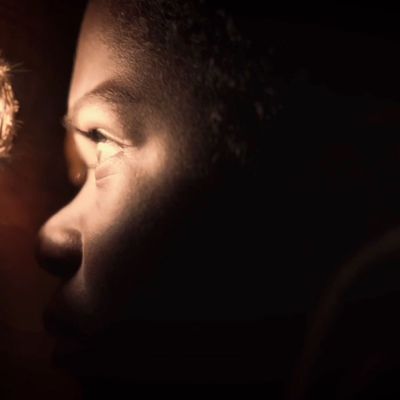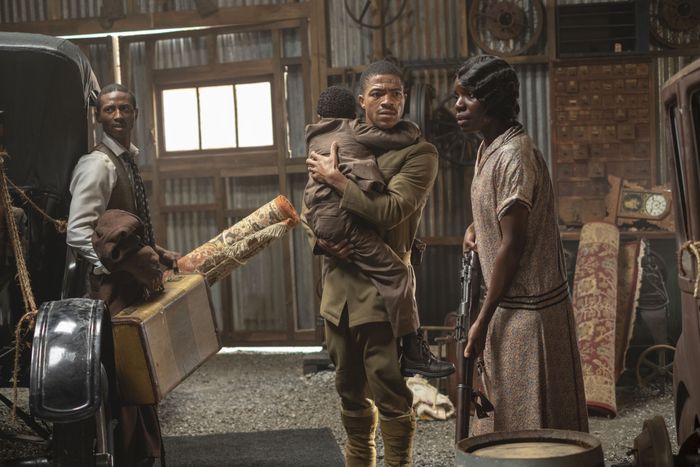
It’s easy to imagine an adaptation of the acclaimed graphic novel Watchmen that’s resolutely nihilistic and conspiracy-minded, told in a similarly gritty antihero style. But HBO’s Watchmen is not that show. Instead, it opens with something more genuinely frightening and radical than any R-rated superhero story. The first episode, “It’s Summer and We’re Running Out of Ice,” begins in 1921, as the black citizens of Tulsa, Oklahoma, are attacked by firebombs, lynch mobs, the Ku Klux Klan, and a low-flying plane in the middle of the day. It looks like a World War I slaughter transposed onto a midwestern backdrop; the visual signifiers of the Americana main street are defamiliarized, shot like a pogrom or a war zone. The scope of the terror is massive.
But unlike much of the Watchmen universe, this is no alternate history. The Tulsa race massacre was real, yet outside of a handful of educational documentaries, it’s all but absent from pop culture. When the massacre gets taught at all, it’s often referred to as a “race riot,” a deceptive title for an incident of large-scale racist violence that destroyed an entire black community. Watchmen showrunner Damon Lindelof, a white man raised in New Jersey, says he hadn’t even heard about the Tulsa massacre until he read about it in Ta-Nehisi Coates’s “The Case for Reparations.”
“I was like, My God, how did this happen?” Lindelof says of learning about this dark chapter in American history, one that saw white Oklahomans killing and brutalizing hundreds of African-Americans and eradicating a thriving cultural and financial district, then called Black Wall Street. “I can’t believe this enclave of African-American businesses, prosperity, culture, movie theaters, confectionery, mechanics, art was completely obliterated in the space of 48 hours.”
This is the reaction co-executive producer and episode director Nicole Kassell predicts many viewers will have when faced with an event that’s widely untaught in American classrooms, and that many white Americans have never learned about. Kassell, who is white, didn’t know about the massacre until hearing about it from Lindelof, and says that even for her assistant on the show, who is from Oklahoma, “it was not in her education at all … it was mentioned literally in one tiny little footnote.” As of 2019, the Tulsa massacre is still not taught in Oklahoma classrooms; educators and legislators are only just now beginning to lay out a plan to begin teaching it before the 100th anniversary of the massacre in 2021.
This was the challenge, for Lindelof and Kassell, in opening Watchmen with this tragedy: How would they depict a racist massacre that has gone underrepresented in media and education with truthfulness and urgency, for an audience that will largely be learning about it for the first time? It was a task that required extensive research, hundreds of actors, and a re-creation of Black Wall Street that had to be built and then set aflame with meticulous, horrific accuracy.
This scene is key to establishing the reality of Watchmen’s Tulsa setting, where, in the present day, there is a reparations program for descendants of the murdered and displaced victims of the massacre. Championed by President Robert Redford, the so-called “Redfordations” incur backlash from a Rorschach-inspired racist militia called the Seventh Kavalry; one of Watchmen’s central mysteries arises from an investigation into Kavalry sympathies within the police force. But where Watchmen’s present day eschews neat one-to-one analogies with the real world, its Tulsa sequence is intended as a direct reflection of American history. As such, Kassell wanted to ensure the episode’s depiction was as accurate as possible, down to the details that have only seconds of screen time. “The man in a woman’s coat … the firemen being held back … all of those, I didn’t make anything up,” she says.
As part of her research, Kassell consulted the book The Burning: Massacre, Destruction, and the Tulsa Race Riot of 1921, which she praises for its “incredible detail from many different voices.” The Burning helped her map out the scene’s progression, which follows a young black boy (Danny Boyd Jr.) and his parents (Steven G. Norfleet and Alexis Louder) as they rush to escape the chaos and violence on Greenwood Avenue. She and the production team also visited the real Greenwood District and consulted with historians at the Greenwood Cultural Center, which preserves records and artifacts from Black Wall Street and the massacre. Kassell notes that the center has photographs and newspapers from around the time of the destruction and the rebuilding period, but that no copies remain of the May 31 newspaper headlines blaring a sensationalized story of a black man’s violence against a white girl, a common technique for stoking racist paranoia and lynching.
“That newspaper headline is what inflamed the mob,” Kassell says. “It was critical to me to get that headline in there, in as organic a way as possible.” In the sequence, you can see the headline underfoot amid the chaos. “The title was ‘To Lynch Negro Tonight,’” explains Kassell, noting that any evidence of that headline had been destroyed. “It was recalled and the original article ripped out … It was actively eradicated.”
Kassell and her production team scouted for a location where they could re-create Greenwood Avenue with as much detail as possible, down to the storefronts and signage. Ultimately they settled on a town in Georgia where they could film the central sequence of a black family weaving through the carnage amid a re-creation of local landmarks like the Mount Zion Baptist Church and the Dreamland Theater.
That latter setting is key to Watchmen’s opening moments, in which a young boy watches a silent film about black deputy U.S. Marshal Bass Reeves, a black-and-white pastiche intended as a tribute to African-American filmmaker Oscar Micheaux. “His work was actually very political, and very much in reaction to Birth of a Nation,” explains Kassell. But Micheaux never made a film about Reeves. The film we see in the episode is “entirely a creation of Damon,” says Kassell, who notes that it’s “absolutely thematically essential” to the series to open with this sequence.
“The first words of the show are that little boy saying, ‘There will be no mob justice today. Trust in the law.’ I think those are the most important words, really, in the whole series. One of the main stories is, what happens when there is mob justice and you can’t trust in the law?”
Kassell also sees this opening as an important signal to the viewer that this won’t be another familiar superhero retread: “For the first frame of a [series] called Watchmen to be a black-and-white silent film was an immediate indication to the audience that this is not what you might expect it to be.”
From the Dreamland Theater sequence, the opening scene then has dramatize a historical tragedy at a scale heretofore never attempted, and depicts it all from the limited perspective of a small child being rushed through the smoke and gunfire to a convoy truck. Unlike the imagined Bass Reeves film, the images in this part of the sequence are all based on true events that Lindelof and Kassell gleaned from Burning and their research in Tulsa. One detail that Lindelof and Kassell made sure to include was a slow-flying airplane attacking black civilians, but Kassell says there were also several vignettes that were adapted and staged that didn’t make it into the final cut: “There was a dog that ran by with its tail on fire. There were white spectators just watching. You know, white women just came to see the show.”
In order to coordinate all of the disparate vignettes and maximize a two-day shoot in Georgia, the production team mocked up the street on a studio lot and orchestrated run-throughs with first assistant director Keri Bruno and a small group of background actors. Because the final sequence would involve a cast of 200 extras and stunt performers, Kassell says that “for the psychological support and safety, it allowed those background people to be the kind of team captains for each vignette.” As the background performers rehearsed with Bruno, Kassell rehearsed separately with the sequence’s core family.
The first day of filming in Georgia — which took place, by coincidence, on the 97th anniversary of the Massacre — Lindelof wrote a letter to the cast and crew explaining the history and legacy of what they were about to shoot. The reverence for the moment didn’t end there: Kassell’s AD created a board with the history of Tulsa for people to consult on set, and a priest was brought in to bless the set, “just to kind of emotionally bring us all together,” Kassell says.
That reverential atmosphere was the setting for the final cut of highly orchestrated chaos and violence that appears in the episode. All of the various stunts — men getting dragged across the ground, a woman thrown over a bench — were filmed in three-minute extended takes of the family’s escape, with cameras on long lenses hidden throughout the set to capture different vignettes of brutality. “It’s pretty amazing to me,” Kassell says, “how much we got in a very tight sequence.”
The end result is the first major dramatization of an event that was not properly recognized for nearly a century. Kassell is aware of what it means to be bringing this story to the screen, particularly as a white woman, “and the privileges that come with that.” She says that there was “a constant discussion” during the making of Watchmen about how the series approaches race and representation, a discussion she sees as part of “a real shift across the board of people addressing this — and a reckoning.”
“At least 400 people were murdered and 10,000 people were just frog-walked out of their beautiful suburban homes and dispersed,” Lindelof says. “This has been basically erased by history.” But after “It’s Summer and We’re Running Out of Ice,” the brutal reality of this historical atrocity has started to come back into focus, for both Watchmen’s viewers and its creators. As Kassell puts it: “Now I grieve.”



